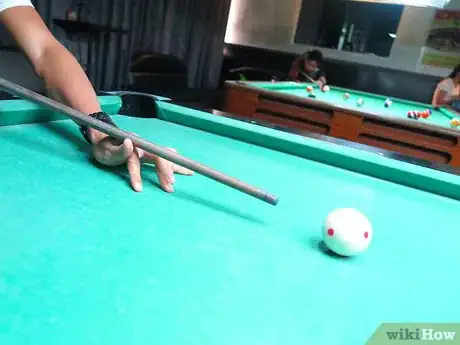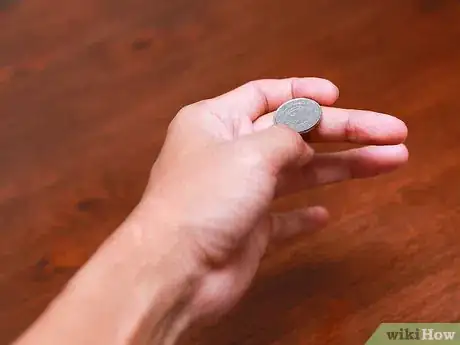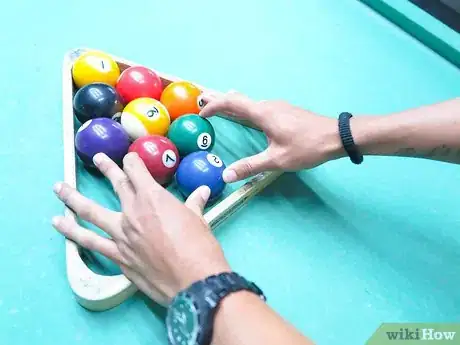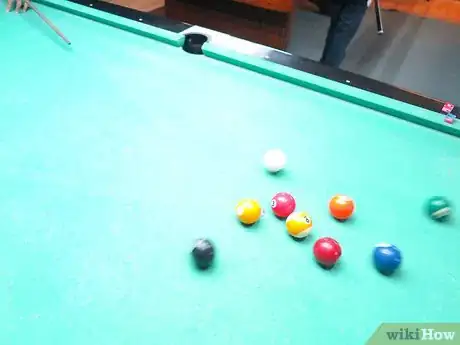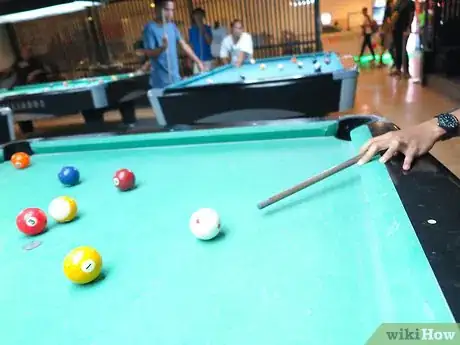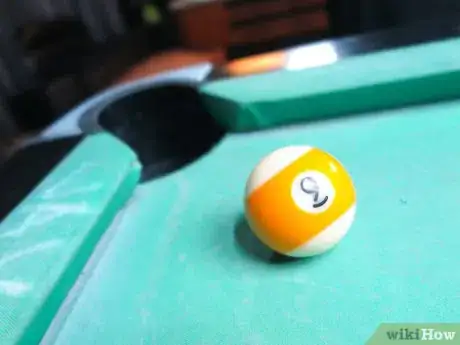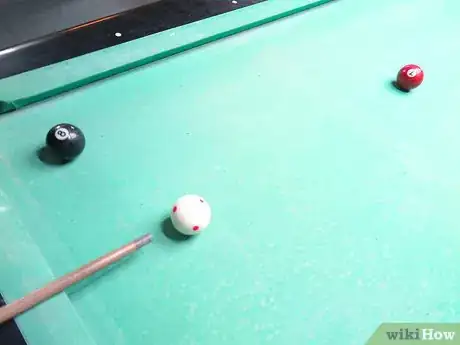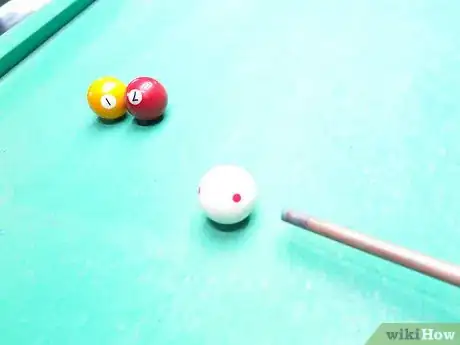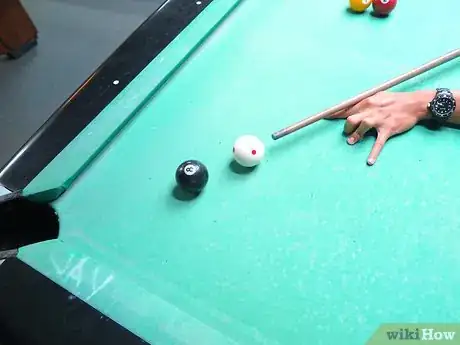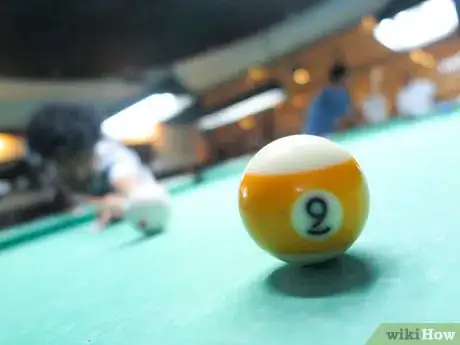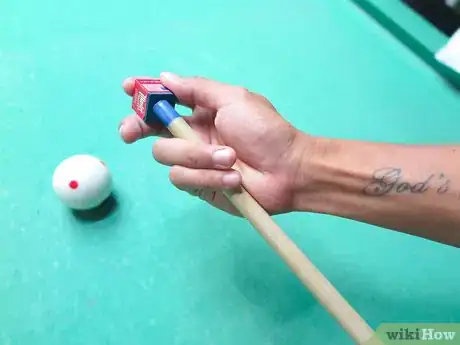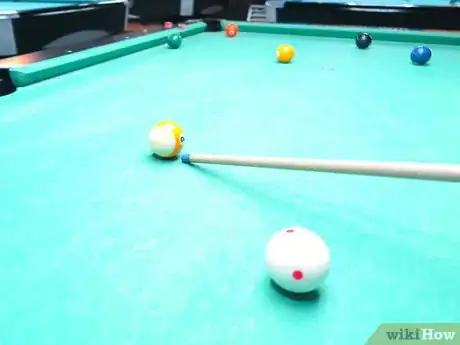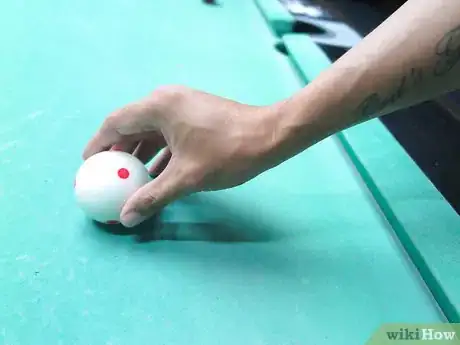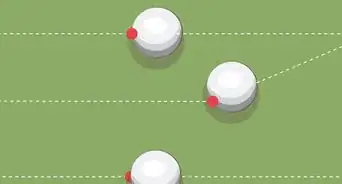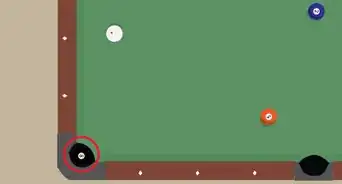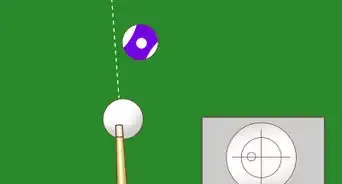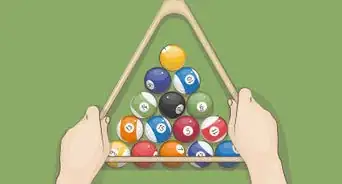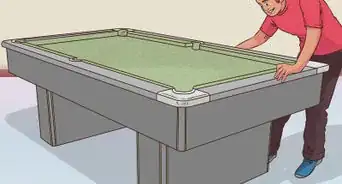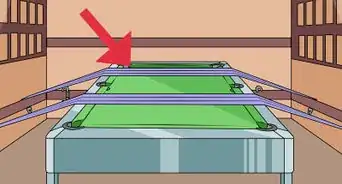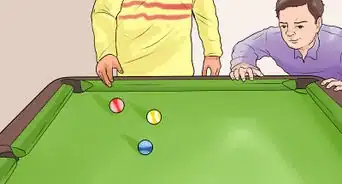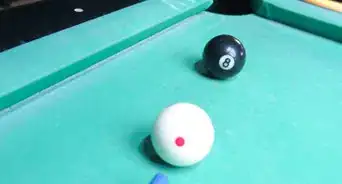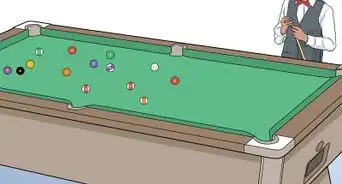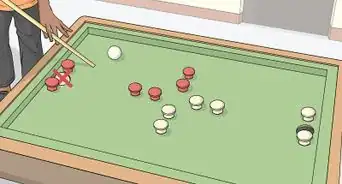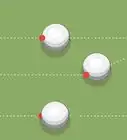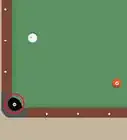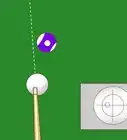wikiHow is a “wiki,” similar to Wikipedia, which means that many of our articles are co-written by multiple authors. To create this article, 23 people, some anonymous, worked to edit and improve it over time.
This article has been viewed 419,707 times.
Learn more...
The simple rules and straightforward goal of 9-ball pool make it easy for new players to learn. More advanced pool players might enjoy this fast-paced change from other pool games, and the opportunity to show off precise positioning skills. All you need to get started is a standard set of pool table equipment.
Steps
Getting Started
-
1Choose teams. 9-Ball is usually played one-on-one. If you have more than two people, divide into two teams.
- In a friendly game, you can play with three or more teams. This is not recommended if some of you are much better at pool than others.
-
2Decide who goes first. You can just flip a coin, but "lagging" is a more entertaining way to decide the first player. On an empty table, every player places a ball just behind the head string. Each player hits his ball at the same time. The goal is to have your ball touch the far end of the table, then bounce back as far as possible without touching the near end or the sides. Whoever gets closest gets to break (see below).
- Try again if two of the balls touch each other, or if no one manages to hit the end without touching another side.
Advertisement -
3Set up nine balls inside the rack. Pick out the nine balls numbered 1 through 9, and place them inside the rack. Arrange them in a diamond shape, with the 9-ball in the center and the 1-ball closest to the shooter. Place balls in the rest of the diamond at random.
- The rack goes in the usual place, with the closest point on top of the foot spot.
- If you can find a diamond-shaped 9-ball rack, use it. If you have to use a triangular 15-ball rack, just make the diamond shape as tightly packed as you can.
-
4Break. Have the first player set down the white cue ball anywhere behind the head string. That player hits the cue ball at the 1-ball to break.
- The break should pocket one ball, and/or send at least three balls to any rail (side).[1] If neither of these happens, set up the rack again and let the next player break instead.
Basic Rules
-
1Take your turn until you fail to pocket a ball. Whenever you pocket a ball, you get to take another shot. Continue taking shots until you fail to pocket a ball, or you foul. When this happens, play passes to the next player.
- This includes the break: if the person who broke pocketed a ball, they get to take another shot.
- Just like 8-ball, you can only hit the cue ball, usually a white ball with no numbers.
-
2Know your objective. In 9-ball pool, whoever pockets the 9-ball wins the game. You can even win on the break this way! Of course, there are other rules that makes this goal harder than it sounds.
-
3Aim for the lowest-numbered ball. Every time you take a shot, the cue ball must hit the lowest-numbered ball still on the table, before it hits any other balls. If it hits a different ball first, or if it doesn't hit any balls, the shot is a foul. (See below for more info on fouls.)
- You can pocket any numbered ball without a penalty. For example, the cue ball can hit the 1-ball, then bounce off and knock the 7-ball into a pocket. This is a legal shot. You can even pocket the 9-ball this way to win the game.
-
4Avoid soft hits. After hitting the lowest-numbered ball, at least one ball must hit a rail or enter a pocket. If this does not happen, the shot is a foul.[2]
-
5Place the ball anywhere if your opponent fouls. If a player commits a foul, the next player picks up the cue ball and places it anywhere on the table before making her shot.[3] As mentioned above, fouls include hitting the wrong ball first, or failing to drive any ball into a pocket or rail.
-
6Obey standard pool rules. Standard pool fouls also apply: knocking a ball off a table, pocketing the cue ball ("scratching"), touching a moving ball, or hitting the cue ball out of turn are all fouls. The next player gets to move the cue ball anywhere on the table.
- If the 9-ball is knocked off or pocketed during a foul, "spot" it back to the foot spot, or as close behind the foot spot as possible. Other numbered balls that leave the table illegally stay out of play.
- Accidentally touching a non-moving ball is not a foul, but the other players get to decide whether to leave it in the new position or move it back.
-
7Play several games. Compared to other types of pool, 9-ball plays ends quickly. Typically, the players agree to play until one person or team has won a certain number of games. Try playing first to three games if you are new pool players, or first to seven if you are intermediate or advanced.
The Push-Out
-
1Add this rule for more competitive play. The push out rule gives the players a little more control over the starting position following the break. This adds more strategy to competitive matches. In a friendly game involving beginner pool players, this rule is not necessary.
-
2Declare "Push out" right after a break. The push out rule only applies on the first shot following a break. The player about to take the second shot can choose to announce a "push out." If he does not announce it, then play proceeds as usual.
- If the shooter pocketed a ball on the break, he may announce a push out, since he's about to take another shot. If he did not pocket a ball, the next player gets the option to push out instead.
-
3Ignore the 9-ball rules for the push out. On an announced push out shot, the shooter does not have to hit the lowest-numbered ball, and does not have to send a ball at a rail or pocket.[4]
- If the push out pockets a 9-ball, "spot" it back to the foot spot. Any other numbered ball stays in the pocket.
- Other foul rules still apply.
-
4Let the next player choose whether to play. After the push-out, the next player chooses whether to play or to pass the turn. She gets to make this decision even if the "push out" pocketed a ball. After this decision, play proceeds as usual.
- If a foul occurred on the push out, follow the usual foul rules instead. The next player places the cue ball anywhere and takes a shot.
Community Q&A
-
QuestionIf I use the 1 ball to get the 9 ball into the pocket, do I win?
 Community AnswerYes, you win as long as the 9 ball is pocketed and your first strike was on the 1 ball. It doesn't matter how many balls you pocket along with 9.
Community AnswerYes, you win as long as the 9 ball is pocketed and your first strike was on the 1 ball. It doesn't matter how many balls you pocket along with 9. -
QuestionWhat is a push-out?
 Community AnswerIt is a shot that balances both players' likelihoods of winning a game. If the breaking player makes a ball but doesn't have position for the lowest-numbered ball, or if the breaking player doesn't make any balls and the incoming player doesn't have position for the lowest-numbered ball, the player may elect to play a push-out shot by hitting the cue ball anywhere on the table. Contacting the lowest-numbered ball or a rail is optional, but standard cue ball rules (no scooping or double hits) still apply. The incoming player after the push-out shot has the option to either play the next shot or pass it back to the opponent.
Community AnswerIt is a shot that balances both players' likelihoods of winning a game. If the breaking player makes a ball but doesn't have position for the lowest-numbered ball, or if the breaking player doesn't make any balls and the incoming player doesn't have position for the lowest-numbered ball, the player may elect to play a push-out shot by hitting the cue ball anywhere on the table. Contacting the lowest-numbered ball or a rail is optional, but standard cue ball rules (no scooping or double hits) still apply. The incoming player after the push-out shot has the option to either play the next shot or pass it back to the opponent. -
QuestionCan I use another ball to sink my objective ball in 9 ball pool?
 Community AnswerYes. As long as the cue ball touches the lowest number ball on the table first, it does not matter which ball you sink.
Community AnswerYes. As long as the cue ball touches the lowest number ball on the table first, it does not matter which ball you sink.
Warnings
- At tournaments, your shot is a foul if both of your feet are off the floor, or if the cue tip is still touching the cue ball when the cue ball contacts another ball. You don't need to play with these rules in a friendly game.⧼thumbs_response⧽
Things You'll Need
- Two or more players
- Pocket billiard table
- Cue stick
- 9 numbered billiard balls
References
About This Article
9-ball is a popular game of pool played with 2 players. The objective of the game is to legally sink the 9 ball. Unlike 8-ball, also known as “stripes and solids,” 9 ball is a type of rotational pool, which means that both players are trying to pocket the same balls in order from 1 to 9. To set the balls up, rack the balls at the foot spot in a diamond shape, with the 1 ball in front and the 9 ball in the middle of the diamond. The rest of the balls should be arranged randomly around the 9. The starting player breaks the rack by shooting at the 1 ball from the kitchen. If they pocket any ball on the break, they continue to shoot. If they don’t pocket a ball, the next player shoots. When shooting, the active player must hit the lowest number ball on the table. For example, if they sink the 1 ball on the break, they must make contact with the 2 ball on their next shot. If they sink the 2, they move on to the 3 and so on. However, combination shots are allowed. So, if a player hits the 1 ball and that 1 ball knocks in a higher-numbered ball, they continue shooting. The active player keeps shooting until they fail to legally pocket a ball or they scratch. A scratch occurs if a player fails to hit the lowest-numbered ball available, they sink the cue ball, or they fail to hit a rail or pocket a ball after making first contact with an object ball. When a player scratches, their opponent picks the cue ball up and places it anywhere on the table before taking their next shot. If any player scratches on 3 consecutive turns, they lose. Play continues until a player wins by sinking the 9 ball or by default when the other player scratches 3 times in a row. To learn how to play more competitive 9-ball pool by using the push-out rule, keep reading!
